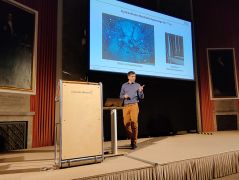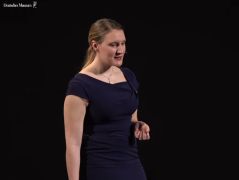MLZ is a cooperation between:
 > Technische Universität München
> Technische Universität München > Helmholtz-Zentrum Hereon
> Helmholtz-Zentrum Hereon
 > Forschungszentrum Jülich
> Forschungszentrum Jülich
MLZ is a member of:
 > LENS
> LENS > ERF-AISBL
> ERF-AISBL
MLZ on social media:

MLZ (eng)
Lichtenbergstr.1
85748 Garching
02.05.2024
Ice-cold screening
Have you ever thought about how strawberries for muesli are freeze-dried? How do you prevent the needles of pre-filled syringes from clogging up so that medication is not injected correctly? Or: How did dinosaurs breed? Dr. Michael Schulz’s “Science for Everyone” lecture at the Deutsches Museum provided answers – now also on YouTube.

Using a purely optical model, Dr. Michael Schulz demonstrates the basic concept of imaging techniques. © Deutsches Museum
In the new premises of the Deutsches Museum and via livestream, Michael Schulz inspired over 200 spectators with the research possibilities of neutrons. The imaging processes at the FRM II research neutron source and the Heinz Maier-Leibnitz Zentrum (MLZ) in Garching can be used to examine various objects such as batteries, archaeological finds, and medical devices.
From dinosaurs to cars
The lecture was not only about the freeze-drying process, which the neutrons illuminate but also about pre-filled syringes that many chronically ill people use daily. The researchers have even examined oviraptor eggs with neutrons to investigate how the dinosaurs bred 60 million years ago. Together with the car and battery industry, they have used neutrons to investigate the process of filling batteries with electrolytes to save costs in the production process and improve safety. To give the audience a better understanding of his work as a scientist, Michael Schulz used an optical model of one of his instruments to demonstrate the basics of imaging procedures.

After the lecture, visitors had the opportunity to talk further with Dr. Michael Schulz and scientists from his team. © FRM II/TUM
Neutrons for Everyone
The audience’s enthusiasm was palpable, especially when Dr. Schulz addressed how the MLZ provides both external researchers and industrial customers access to its powerful research equipment. The way these instruments work also sparked interested questions from the guests.
With a concluding word, the Scientific Director, Prof. Dr. Christian Pfleiderer, invited the audience to try the imaging process on the model he had brought with him and to visit the FRM II research neutron source in Garching in person.
- Lecture by Dr. Michael Schulz from February 28, 2024 – now on the YouTube Channel of the Deutsches Museum (German)
- Plan your Visit to the Research Neutron Source FRM II now!
Related News
-
04.03.2021
Can electrons waltz?
MLZ is a cooperation between:
 > Technische Universität München
> Technische Universität München > Helmholtz-Zentrum Hereon
> Helmholtz-Zentrum Hereon
 > Forschungszentrum Jülich
> Forschungszentrum Jülich
MLZ is a member of:
 > LENS
> LENS > ERF-AISBL
> ERF-AISBL
MLZ on social media:





